E-commerce Strategy: University International Students
VerifiedAdded on 2021/04/21
|11
|1777
|213
Report
AI Summary
This report presents an analysis of an e-commerce strategy designed to increase the number of international students at De Montfort University in the UK. The report begins with an introduction outlining the university's goals of expanding its online course offerings and attracting students from countries such as India, Malaysia, and China. Part 1 of the report conducts a SWOT analysis, identifying the university's strengths, such as asynchronous learning and effective online marketing, and weaknesses like lack of course information. Part 2 employs Porter's five forces model to evaluate the external environment, assessing the threats of new entrants, substitute products, the bargaining power of suppliers and customers, and competitive rivalry. The report recommends strategies to leverage strengths and mitigate weaknesses, such as improving online marketing and communication. The report concludes with a summary of the findings and a list of references.
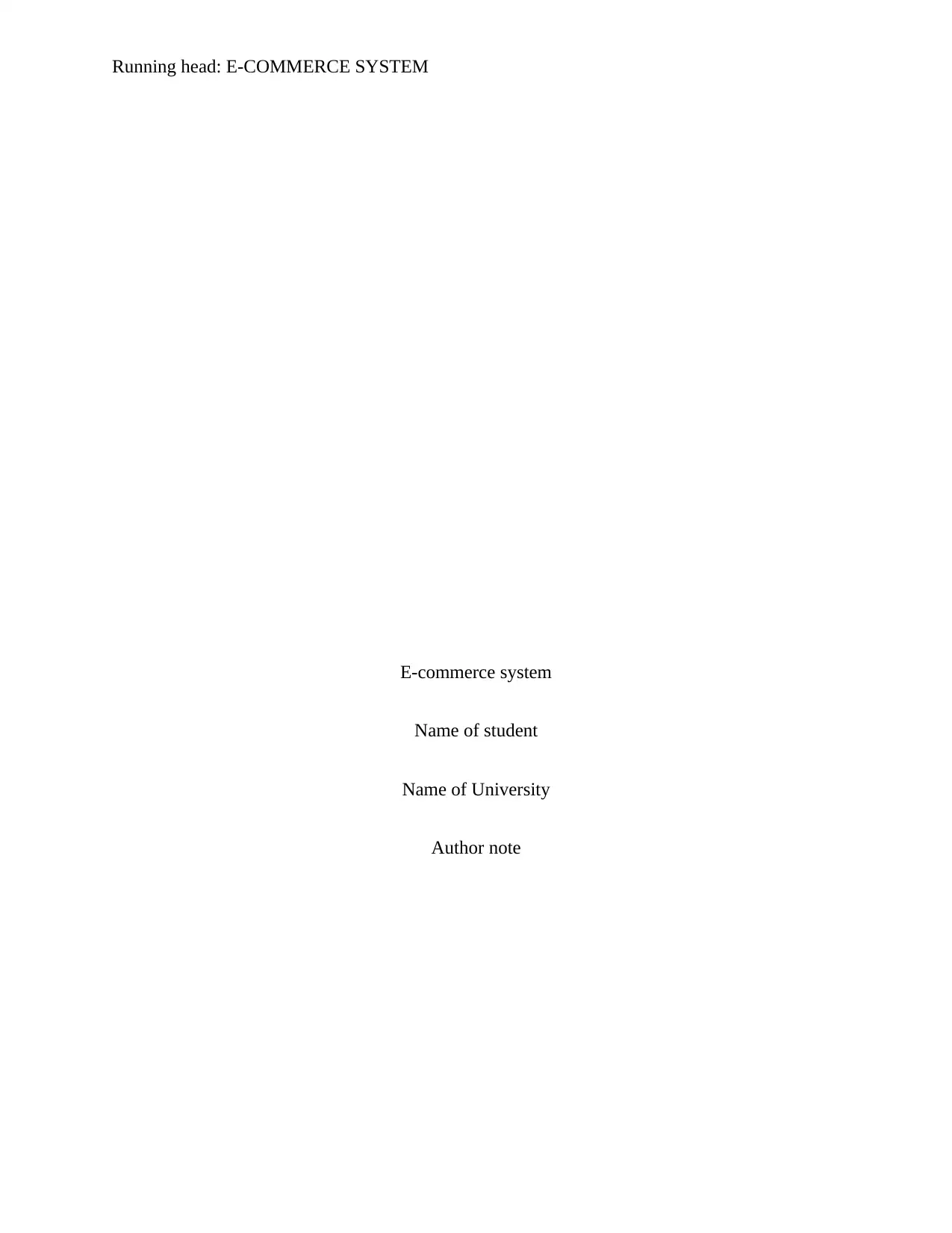
Running head: E-COMMERCE SYSTEM
E-commerce system
Name of student
Name of University
Author note
E-commerce system
Name of student
Name of University
Author note
Paraphrase This Document
Need a fresh take? Get an instant paraphrase of this document with our AI Paraphraser
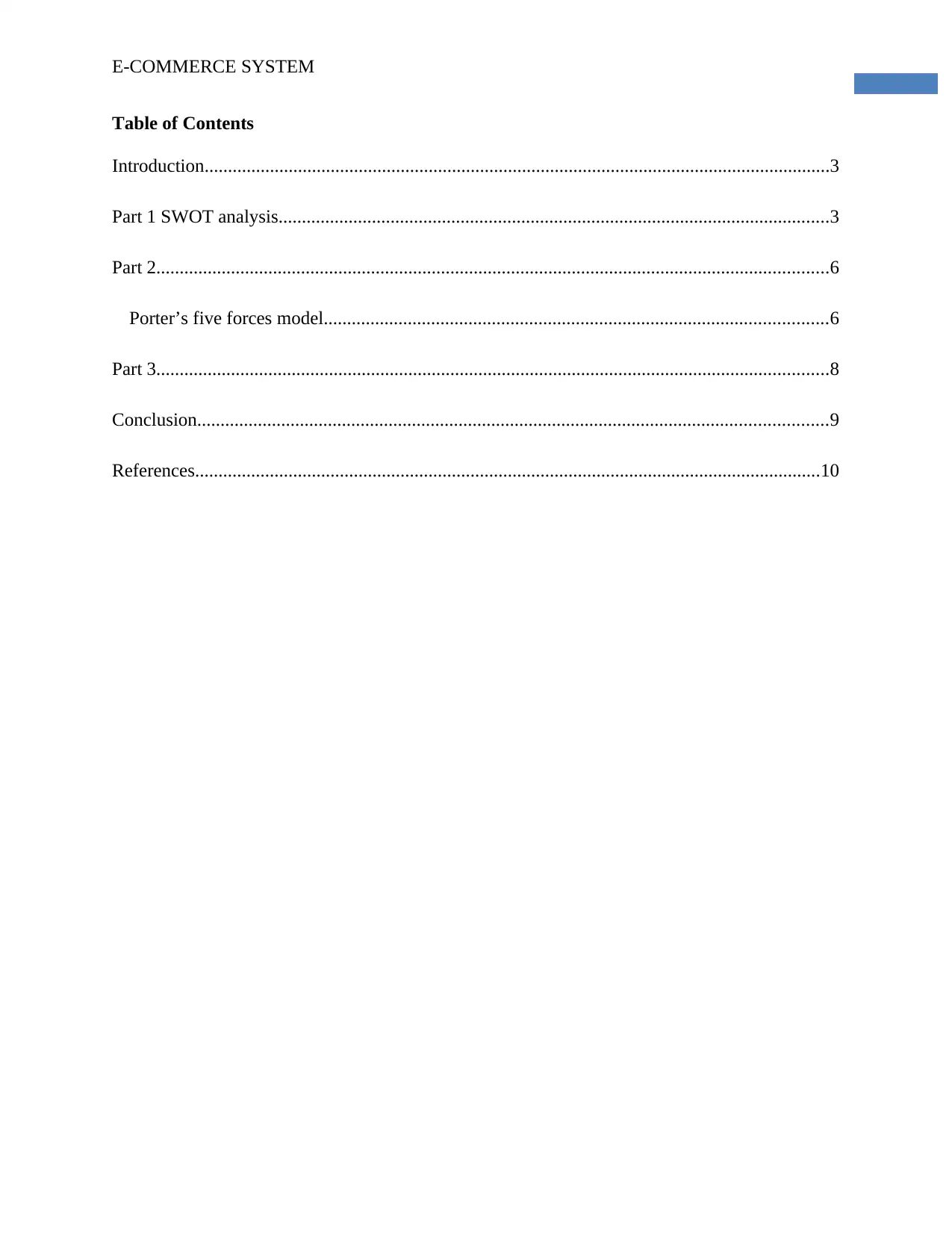
1
E-COMMERCE SYSTEM
Table of Contents
Introduction......................................................................................................................................3
Part 1 SWOT analysis......................................................................................................................3
Part 2................................................................................................................................................6
Porter’s five forces model............................................................................................................6
Part 3................................................................................................................................................8
Conclusion.......................................................................................................................................9
References......................................................................................................................................10
E-COMMERCE SYSTEM
Table of Contents
Introduction......................................................................................................................................3
Part 1 SWOT analysis......................................................................................................................3
Part 2................................................................................................................................................6
Porter’s five forces model............................................................................................................6
Part 3................................................................................................................................................8
Conclusion.......................................................................................................................................9
References......................................................................................................................................10
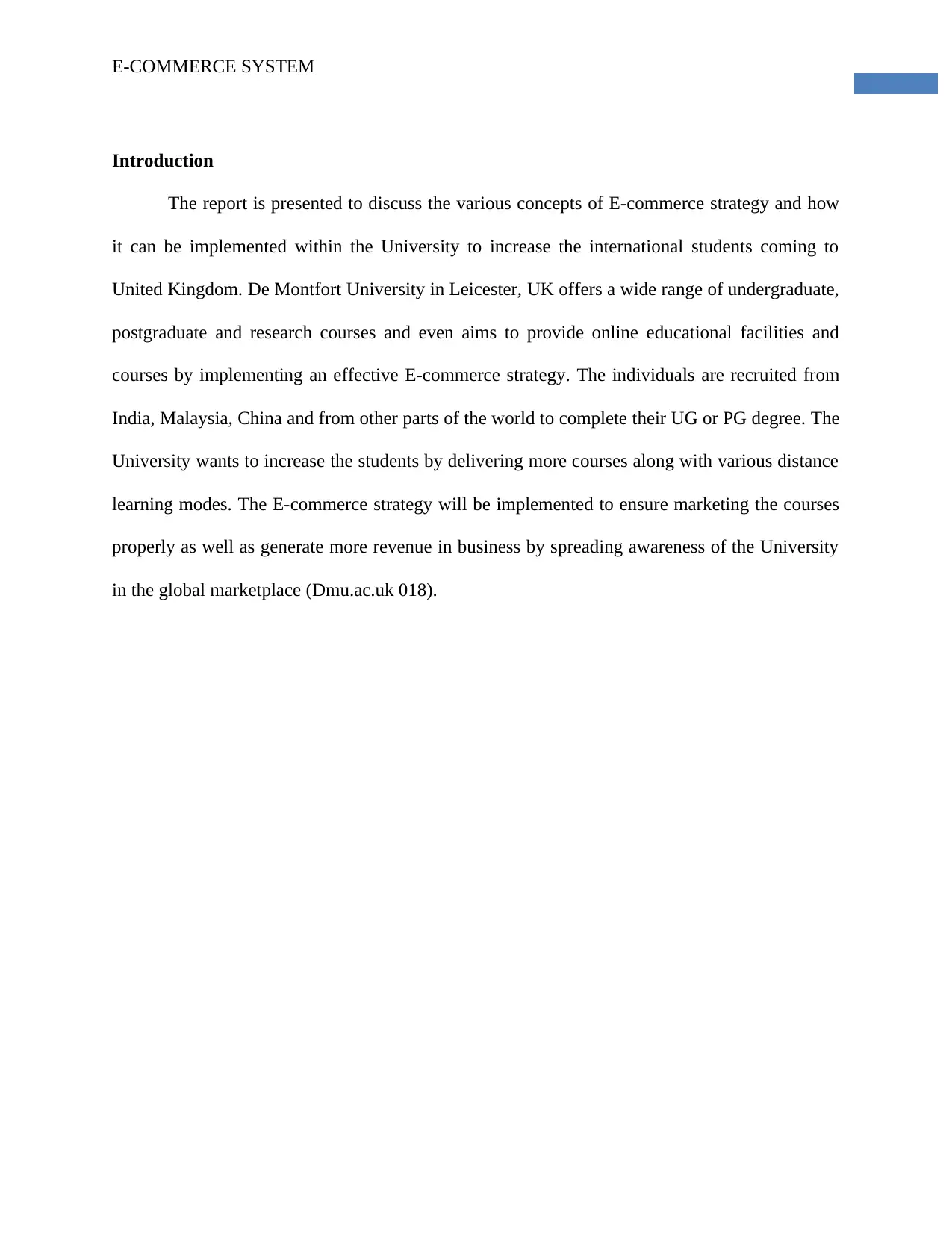
2
E-COMMERCE SYSTEM
Introduction
The report is presented to discuss the various concepts of E-commerce strategy and how
it can be implemented within the University to increase the international students coming to
United Kingdom. De Montfort University in Leicester, UK offers a wide range of undergraduate,
postgraduate and research courses and even aims to provide online educational facilities and
courses by implementing an effective E-commerce strategy. The individuals are recruited from
India, Malaysia, China and from other parts of the world to complete their UG or PG degree. The
University wants to increase the students by delivering more courses along with various distance
learning modes. The E-commerce strategy will be implemented to ensure marketing the courses
properly as well as generate more revenue in business by spreading awareness of the University
in the global marketplace (Dmu.ac.uk 018).
E-COMMERCE SYSTEM
Introduction
The report is presented to discuss the various concepts of E-commerce strategy and how
it can be implemented within the University to increase the international students coming to
United Kingdom. De Montfort University in Leicester, UK offers a wide range of undergraduate,
postgraduate and research courses and even aims to provide online educational facilities and
courses by implementing an effective E-commerce strategy. The individuals are recruited from
India, Malaysia, China and from other parts of the world to complete their UG or PG degree. The
University wants to increase the students by delivering more courses along with various distance
learning modes. The E-commerce strategy will be implemented to ensure marketing the courses
properly as well as generate more revenue in business by spreading awareness of the University
in the global marketplace (Dmu.ac.uk 018).
⊘ This is a preview!⊘
Do you want full access?
Subscribe today to unlock all pages.

Trusted by 1+ million students worldwide
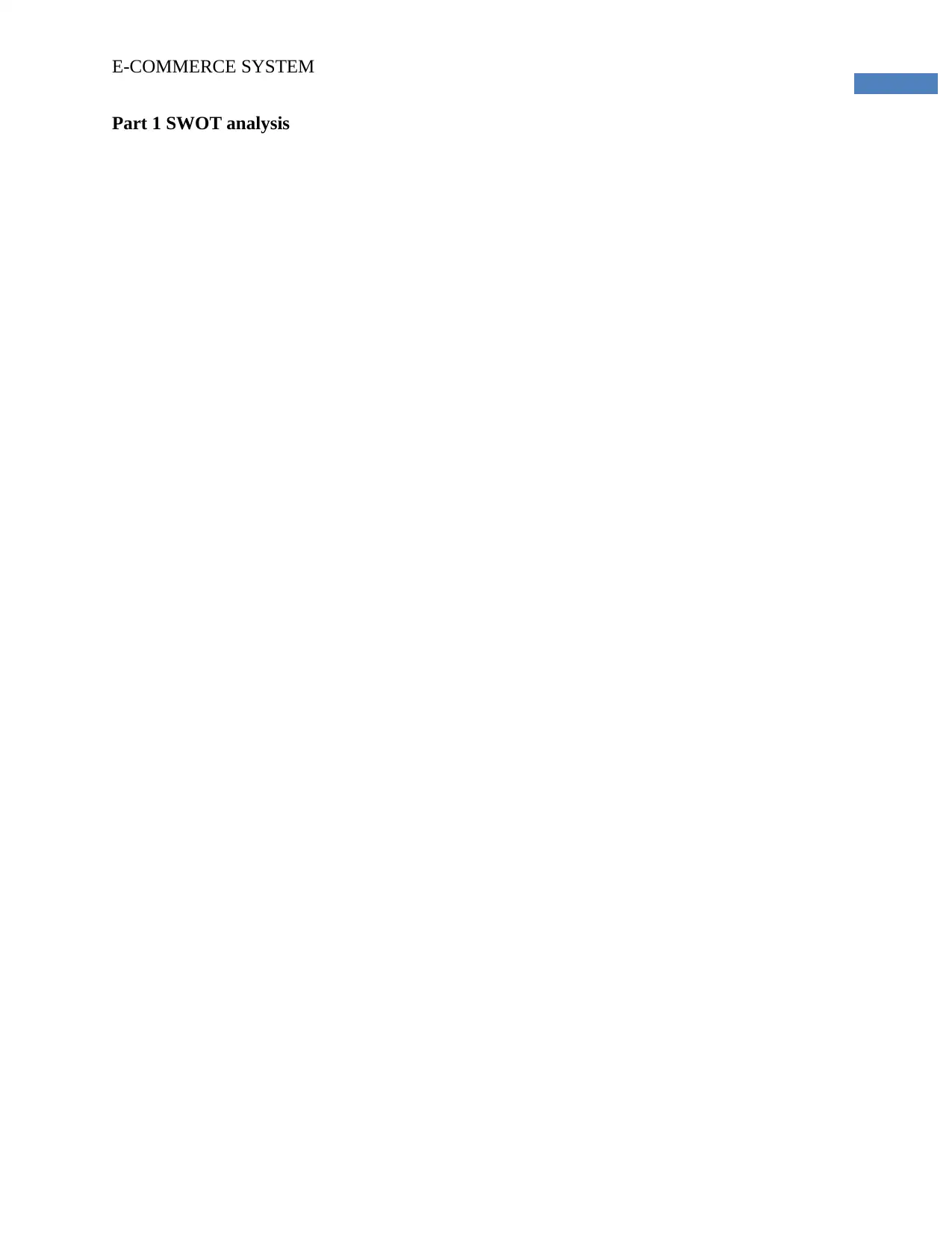
3
E-COMMERCE SYSTEM
Part 1 SWOT analysis
StrengthsDeMontfortUniversityhasaclearstrategicplan,whichmakesitcapableofofferingawidevarietyofcourses.Thestudentsfromoverseasareprovidedwithdistancelearningmethod,whichcreatesconvenienceforthemtostudyandcompleteadegree(HuangandBenyoucef2013).Asynchronouslearningisinteractive,whichhasallowedstudentstoclarifytheirqueriesthroughonlineprograms.Thedistancelearningcoursehassavedalotofmoneyandreducedthetravellingexpensestoo.TheE-commercestrategyandonlinewebsitemanagedbytheUniversityhasmarketedthecoursesquiteefficientlytoattractmorecandidSWOTanalysis
E-COMMERCE SYSTEM
Part 1 SWOT analysis
StrengthsDeMontfortUniversityhasaclearstrategicplan,whichmakesitcapableofofferingawidevarietyofcourses.Thestudentsfromoverseasareprovidedwithdistancelearningmethod,whichcreatesconvenienceforthemtostudyandcompleteadegree(HuangandBenyoucef2013).Asynchronouslearningisinteractive,whichhasallowedstudentstoclarifytheirqueriesthroughonlineprograms.Thedistancelearningcoursehassavedalotofmoneyandreducedthetravellingexpensestoo.TheE-commercestrategyandonlinewebsitemanagedbytheUniversityhasmarketedthecoursesquiteefficientlytoattractmorecandidSWOTanalysis
Paraphrase This Document
Need a fresh take? Get an instant paraphrase of this document with our AI Paraphraser
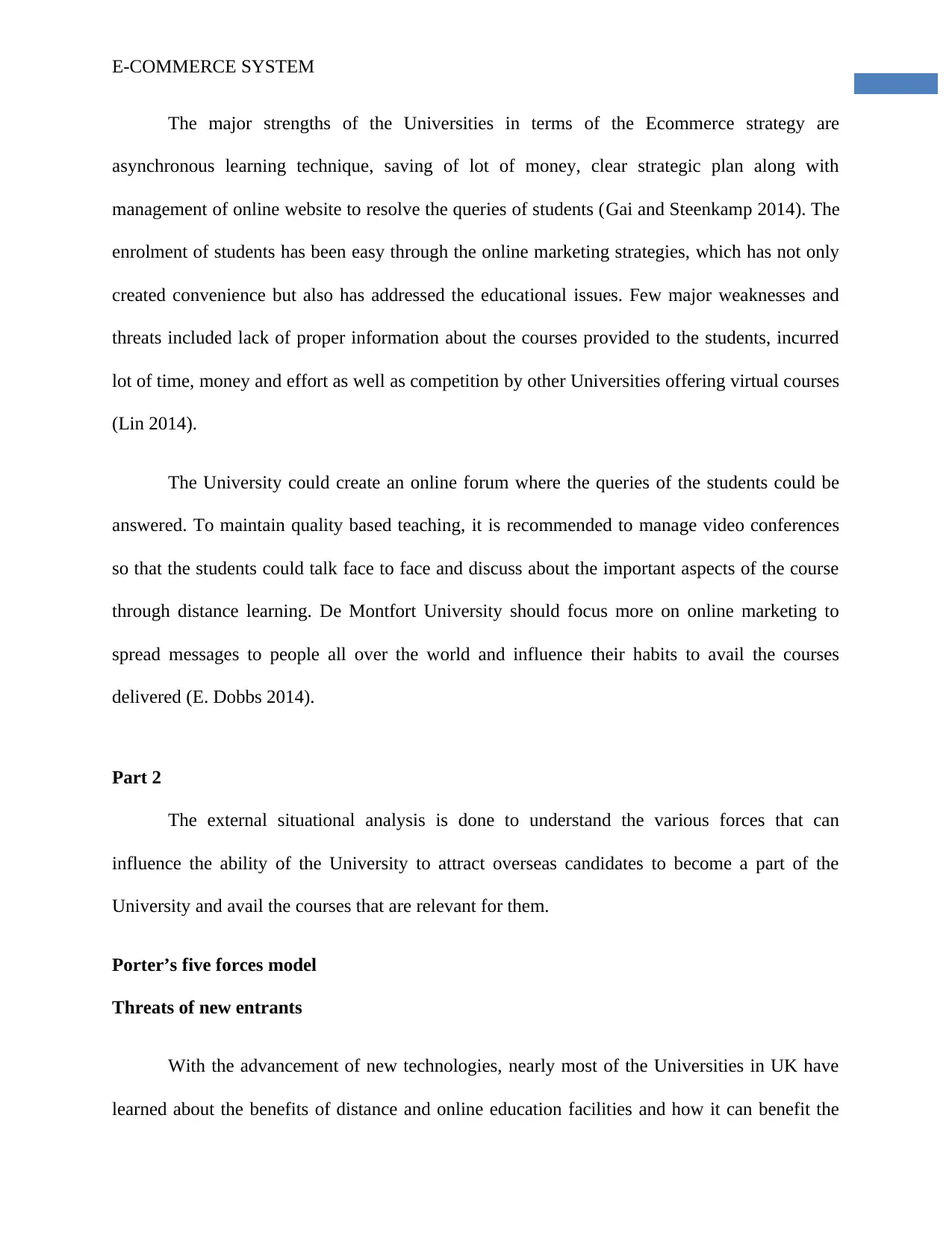
4
E-COMMERCE SYSTEM
The major strengths of the Universities in terms of the Ecommerce strategy are
asynchronous learning technique, saving of lot of money, clear strategic plan along with
management of online website to resolve the queries of students (Gai and Steenkamp 2014). The
enrolment of students has been easy through the online marketing strategies, which has not only
created convenience but also has addressed the educational issues. Few major weaknesses and
threats included lack of proper information about the courses provided to the students, incurred
lot of time, money and effort as well as competition by other Universities offering virtual courses
(Lin 2014).
The University could create an online forum where the queries of the students could be
answered. To maintain quality based teaching, it is recommended to manage video conferences
so that the students could talk face to face and discuss about the important aspects of the course
through distance learning. De Montfort University should focus more on online marketing to
spread messages to people all over the world and influence their habits to avail the courses
delivered (E. Dobbs 2014).
Part 2
The external situational analysis is done to understand the various forces that can
influence the ability of the University to attract overseas candidates to become a part of the
University and avail the courses that are relevant for them.
Porter’s five forces model
Threats of new entrants
With the advancement of new technologies, nearly most of the Universities in UK have
learned about the benefits of distance and online education facilities and how it can benefit the
E-COMMERCE SYSTEM
The major strengths of the Universities in terms of the Ecommerce strategy are
asynchronous learning technique, saving of lot of money, clear strategic plan along with
management of online website to resolve the queries of students (Gai and Steenkamp 2014). The
enrolment of students has been easy through the online marketing strategies, which has not only
created convenience but also has addressed the educational issues. Few major weaknesses and
threats included lack of proper information about the courses provided to the students, incurred
lot of time, money and effort as well as competition by other Universities offering virtual courses
(Lin 2014).
The University could create an online forum where the queries of the students could be
answered. To maintain quality based teaching, it is recommended to manage video conferences
so that the students could talk face to face and discuss about the important aspects of the course
through distance learning. De Montfort University should focus more on online marketing to
spread messages to people all over the world and influence their habits to avail the courses
delivered (E. Dobbs 2014).
Part 2
The external situational analysis is done to understand the various forces that can
influence the ability of the University to attract overseas candidates to become a part of the
University and avail the courses that are relevant for them.
Porter’s five forces model
Threats of new entrants
With the advancement of new technologies, nearly most of the Universities in UK have
learned about the benefits of distance and online education facilities and how it can benefit the
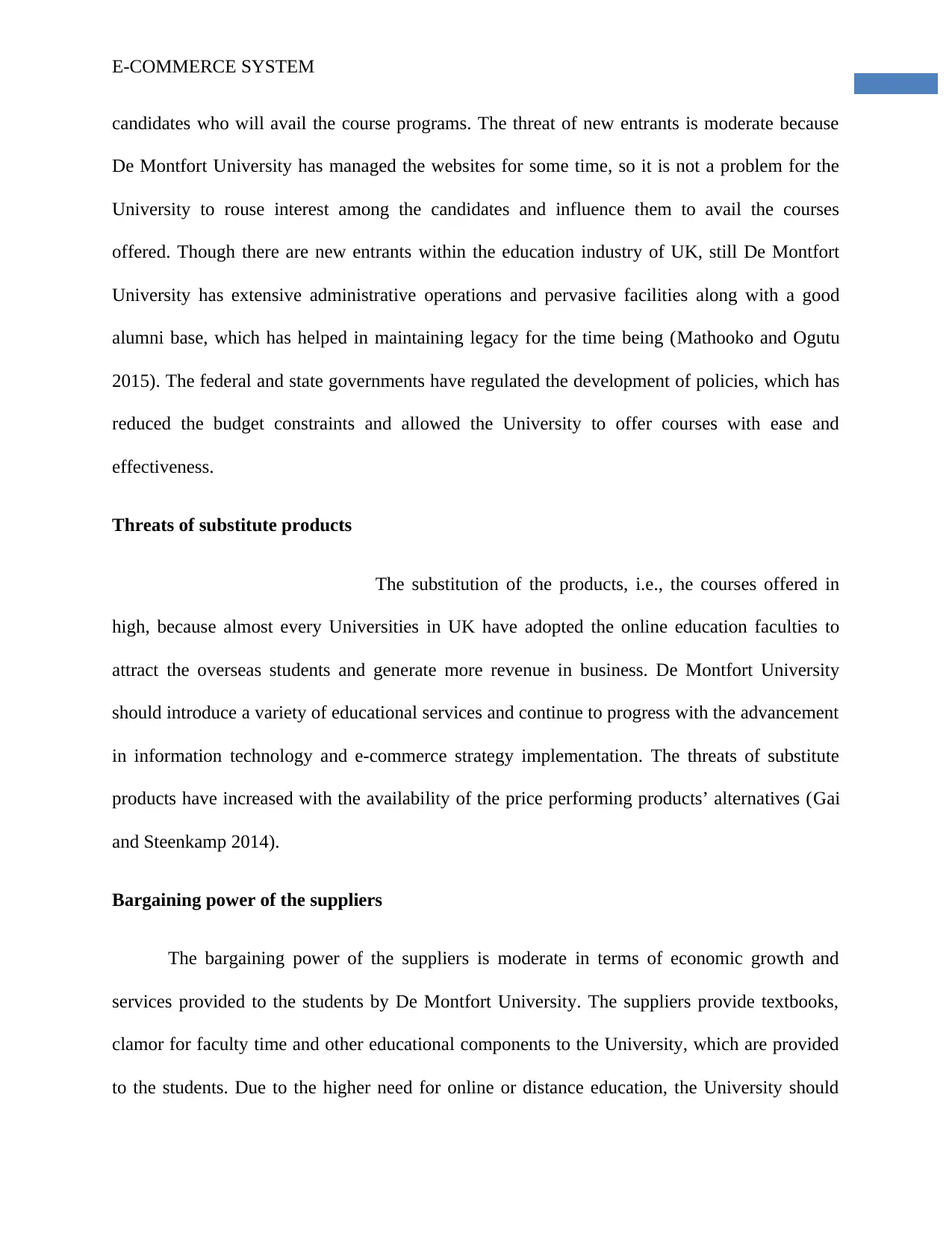
5
E-COMMERCE SYSTEM
candidates who will avail the course programs. The threat of new entrants is moderate because
De Montfort University has managed the websites for some time, so it is not a problem for the
University to rouse interest among the candidates and influence them to avail the courses
offered. Though there are new entrants within the education industry of UK, still De Montfort
University has extensive administrative operations and pervasive facilities along with a good
alumni base, which has helped in maintaining legacy for the time being (Mathooko and Ogutu
2015). The federal and state governments have regulated the development of policies, which has
reduced the budget constraints and allowed the University to offer courses with ease and
effectiveness.
Threats of substitute products
The substitution of the products, i.e., the courses offered in
high, because almost every Universities in UK have adopted the online education faculties to
attract the overseas students and generate more revenue in business. De Montfort University
should introduce a variety of educational services and continue to progress with the advancement
in information technology and e-commerce strategy implementation. The threats of substitute
products have increased with the availability of the price performing products’ alternatives (Gai
and Steenkamp 2014).
Bargaining power of the suppliers
The bargaining power of the suppliers is moderate in terms of economic growth and
services provided to the students by De Montfort University. The suppliers provide textbooks,
clamor for faculty time and other educational components to the University, which are provided
to the students. Due to the higher need for online or distance education, the University should
E-COMMERCE SYSTEM
candidates who will avail the course programs. The threat of new entrants is moderate because
De Montfort University has managed the websites for some time, so it is not a problem for the
University to rouse interest among the candidates and influence them to avail the courses
offered. Though there are new entrants within the education industry of UK, still De Montfort
University has extensive administrative operations and pervasive facilities along with a good
alumni base, which has helped in maintaining legacy for the time being (Mathooko and Ogutu
2015). The federal and state governments have regulated the development of policies, which has
reduced the budget constraints and allowed the University to offer courses with ease and
effectiveness.
Threats of substitute products
The substitution of the products, i.e., the courses offered in
high, because almost every Universities in UK have adopted the online education faculties to
attract the overseas students and generate more revenue in business. De Montfort University
should introduce a variety of educational services and continue to progress with the advancement
in information technology and e-commerce strategy implementation. The threats of substitute
products have increased with the availability of the price performing products’ alternatives (Gai
and Steenkamp 2014).
Bargaining power of the suppliers
The bargaining power of the suppliers is moderate in terms of economic growth and
services provided to the students by De Montfort University. The suppliers provide textbooks,
clamor for faculty time and other educational components to the University, which are provided
to the students. Due to the higher need for online or distance education, the University should
⊘ This is a preview!⊘
Do you want full access?
Subscribe today to unlock all pages.

Trusted by 1+ million students worldwide
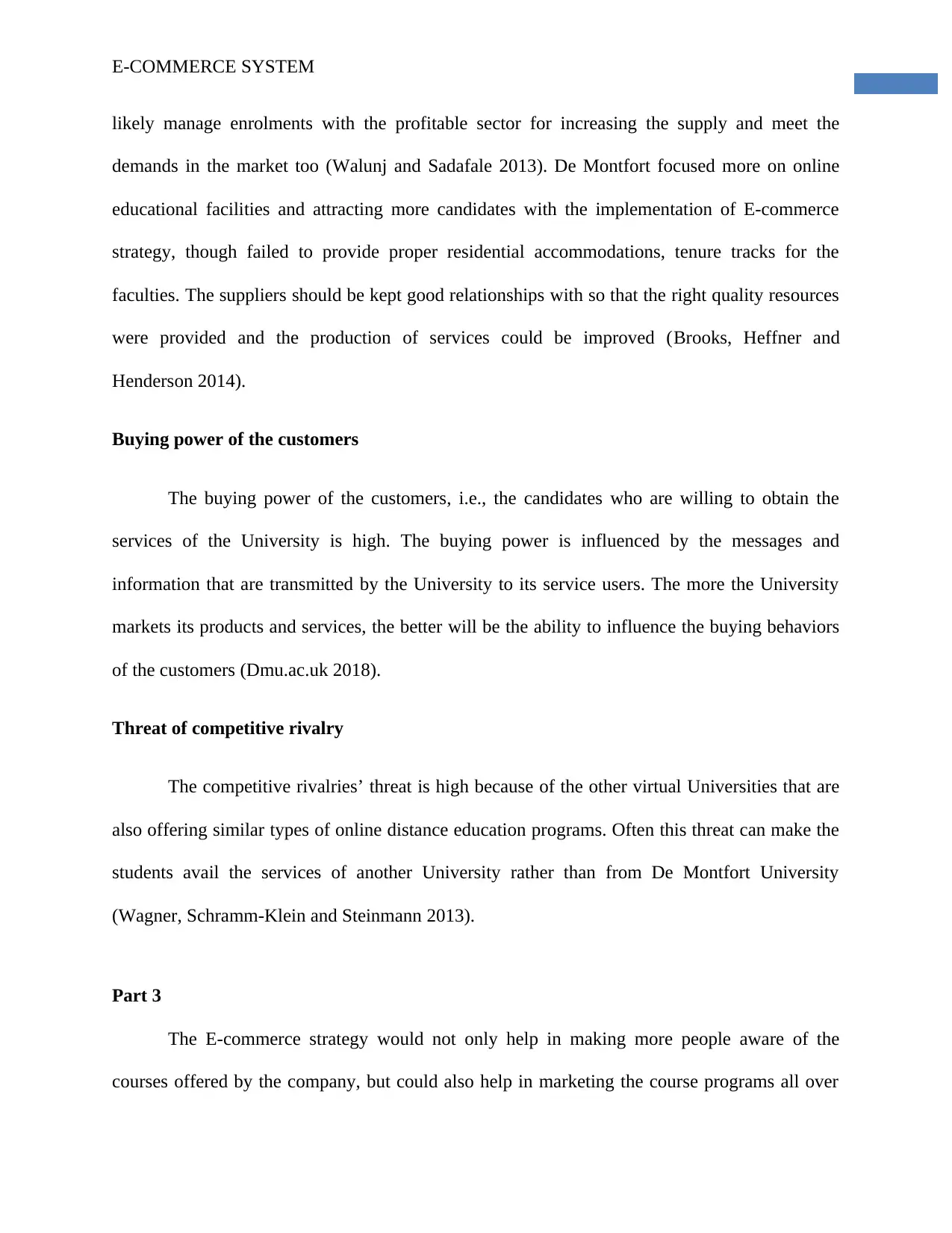
6
E-COMMERCE SYSTEM
likely manage enrolments with the profitable sector for increasing the supply and meet the
demands in the market too (Walunj and Sadafale 2013). De Montfort focused more on online
educational facilities and attracting more candidates with the implementation of E-commerce
strategy, though failed to provide proper residential accommodations, tenure tracks for the
faculties. The suppliers should be kept good relationships with so that the right quality resources
were provided and the production of services could be improved (Brooks, Heffner and
Henderson 2014).
Buying power of the customers
The buying power of the customers, i.e., the candidates who are willing to obtain the
services of the University is high. The buying power is influenced by the messages and
information that are transmitted by the University to its service users. The more the University
markets its products and services, the better will be the ability to influence the buying behaviors
of the customers (Dmu.ac.uk 2018).
Threat of competitive rivalry
The competitive rivalries’ threat is high because of the other virtual Universities that are
also offering similar types of online distance education programs. Often this threat can make the
students avail the services of another University rather than from De Montfort University
(Wagner, Schramm-Klein and Steinmann 2013).
Part 3
The E-commerce strategy would not only help in making more people aware of the
courses offered by the company, but could also help in marketing the course programs all over
E-COMMERCE SYSTEM
likely manage enrolments with the profitable sector for increasing the supply and meet the
demands in the market too (Walunj and Sadafale 2013). De Montfort focused more on online
educational facilities and attracting more candidates with the implementation of E-commerce
strategy, though failed to provide proper residential accommodations, tenure tracks for the
faculties. The suppliers should be kept good relationships with so that the right quality resources
were provided and the production of services could be improved (Brooks, Heffner and
Henderson 2014).
Buying power of the customers
The buying power of the customers, i.e., the candidates who are willing to obtain the
services of the University is high. The buying power is influenced by the messages and
information that are transmitted by the University to its service users. The more the University
markets its products and services, the better will be the ability to influence the buying behaviors
of the customers (Dmu.ac.uk 2018).
Threat of competitive rivalry
The competitive rivalries’ threat is high because of the other virtual Universities that are
also offering similar types of online distance education programs. Often this threat can make the
students avail the services of another University rather than from De Montfort University
(Wagner, Schramm-Klein and Steinmann 2013).
Part 3
The E-commerce strategy would not only help in making more people aware of the
courses offered by the company, but could also help in marketing the course programs all over
Paraphrase This Document
Need a fresh take? Get an instant paraphrase of this document with our AI Paraphraser
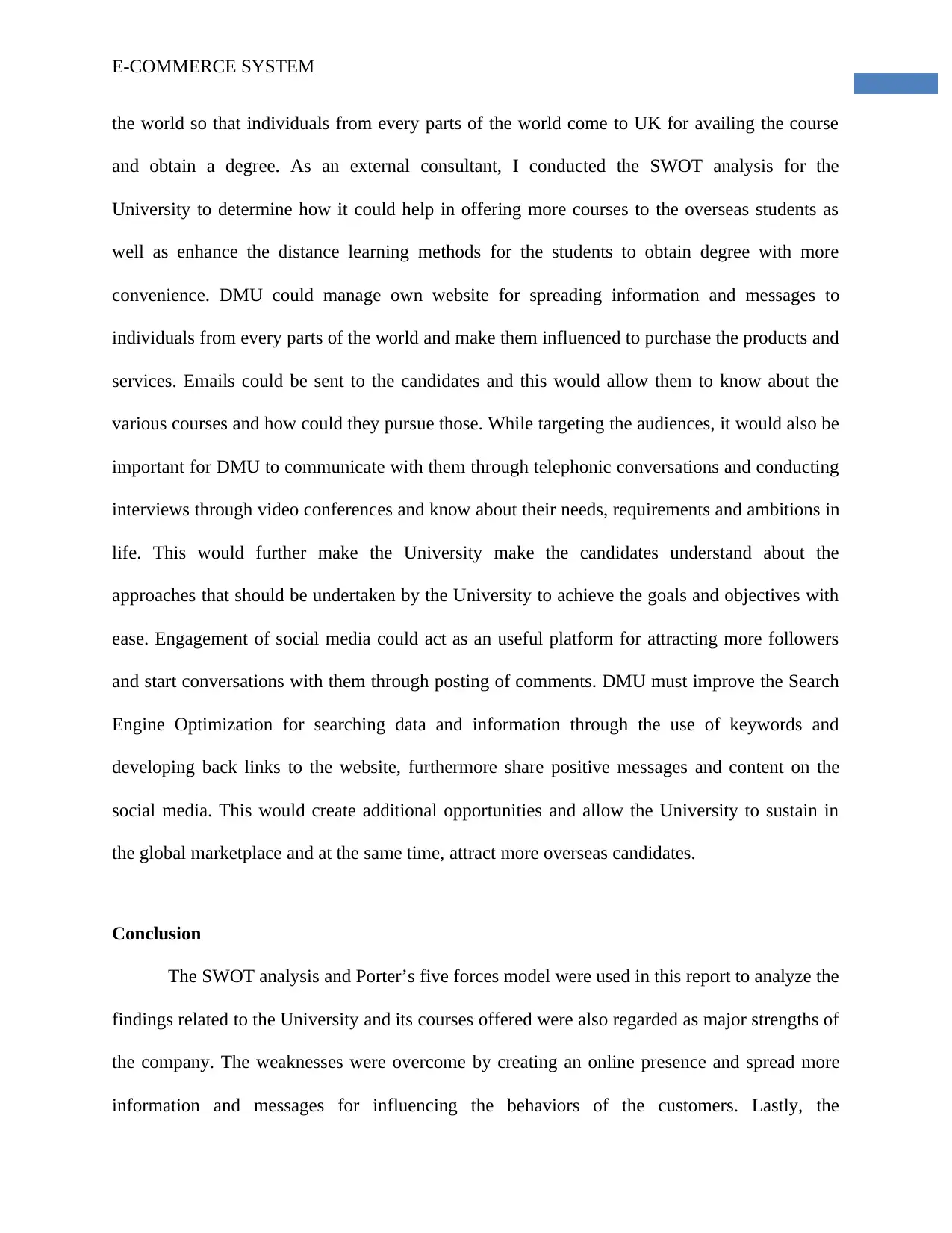
7
E-COMMERCE SYSTEM
the world so that individuals from every parts of the world come to UK for availing the course
and obtain a degree. As an external consultant, I conducted the SWOT analysis for the
University to determine how it could help in offering more courses to the overseas students as
well as enhance the distance learning methods for the students to obtain degree with more
convenience. DMU could manage own website for spreading information and messages to
individuals from every parts of the world and make them influenced to purchase the products and
services. Emails could be sent to the candidates and this would allow them to know about the
various courses and how could they pursue those. While targeting the audiences, it would also be
important for DMU to communicate with them through telephonic conversations and conducting
interviews through video conferences and know about their needs, requirements and ambitions in
life. This would further make the University make the candidates understand about the
approaches that should be undertaken by the University to achieve the goals and objectives with
ease. Engagement of social media could act as an useful platform for attracting more followers
and start conversations with them through posting of comments. DMU must improve the Search
Engine Optimization for searching data and information through the use of keywords and
developing back links to the website, furthermore share positive messages and content on the
social media. This would create additional opportunities and allow the University to sustain in
the global marketplace and at the same time, attract more overseas candidates.
Conclusion
The SWOT analysis and Porter’s five forces model were used in this report to analyze the
findings related to the University and its courses offered were also regarded as major strengths of
the company. The weaknesses were overcome by creating an online presence and spread more
information and messages for influencing the behaviors of the customers. Lastly, the
E-COMMERCE SYSTEM
the world so that individuals from every parts of the world come to UK for availing the course
and obtain a degree. As an external consultant, I conducted the SWOT analysis for the
University to determine how it could help in offering more courses to the overseas students as
well as enhance the distance learning methods for the students to obtain degree with more
convenience. DMU could manage own website for spreading information and messages to
individuals from every parts of the world and make them influenced to purchase the products and
services. Emails could be sent to the candidates and this would allow them to know about the
various courses and how could they pursue those. While targeting the audiences, it would also be
important for DMU to communicate with them through telephonic conversations and conducting
interviews through video conferences and know about their needs, requirements and ambitions in
life. This would further make the University make the candidates understand about the
approaches that should be undertaken by the University to achieve the goals and objectives with
ease. Engagement of social media could act as an useful platform for attracting more followers
and start conversations with them through posting of comments. DMU must improve the Search
Engine Optimization for searching data and information through the use of keywords and
developing back links to the website, furthermore share positive messages and content on the
social media. This would create additional opportunities and allow the University to sustain in
the global marketplace and at the same time, attract more overseas candidates.
Conclusion
The SWOT analysis and Porter’s five forces model were used in this report to analyze the
findings related to the University and its courses offered were also regarded as major strengths of
the company. The weaknesses were overcome by creating an online presence and spread more
information and messages for influencing the behaviors of the customers. Lastly, the
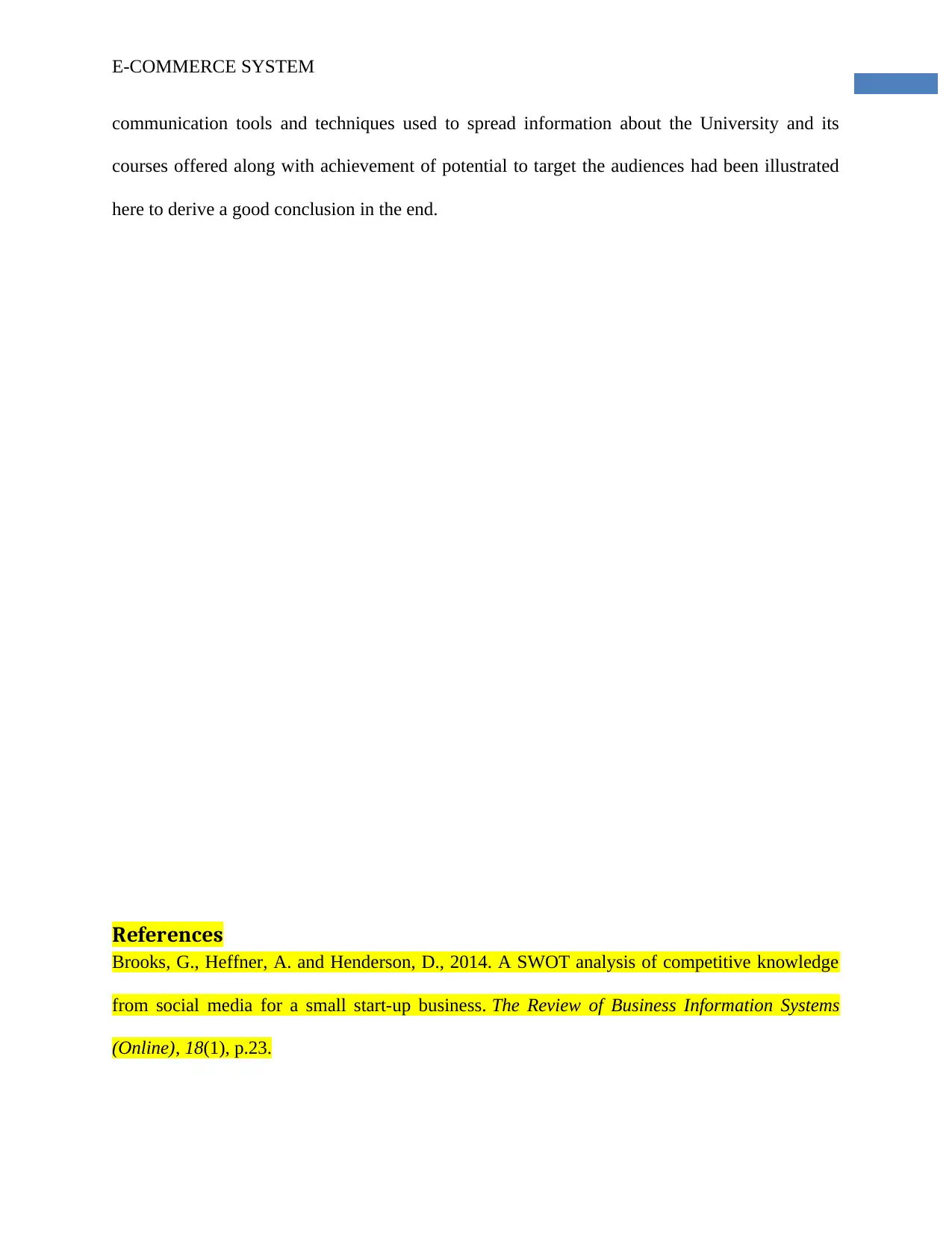
8
E-COMMERCE SYSTEM
communication tools and techniques used to spread information about the University and its
courses offered along with achievement of potential to target the audiences had been illustrated
here to derive a good conclusion in the end.
References
Brooks, G., Heffner, A. and Henderson, D., 2014. A SWOT analysis of competitive knowledge
from social media for a small start-up business. The Review of Business Information Systems
(Online), 18(1), p.23.
E-COMMERCE SYSTEM
communication tools and techniques used to spread information about the University and its
courses offered along with achievement of potential to target the audiences had been illustrated
here to derive a good conclusion in the end.
References
Brooks, G., Heffner, A. and Henderson, D., 2014. A SWOT analysis of competitive knowledge
from social media for a small start-up business. The Review of Business Information Systems
(Online), 18(1), p.23.
⊘ This is a preview!⊘
Do you want full access?
Subscribe today to unlock all pages.

Trusted by 1+ million students worldwide
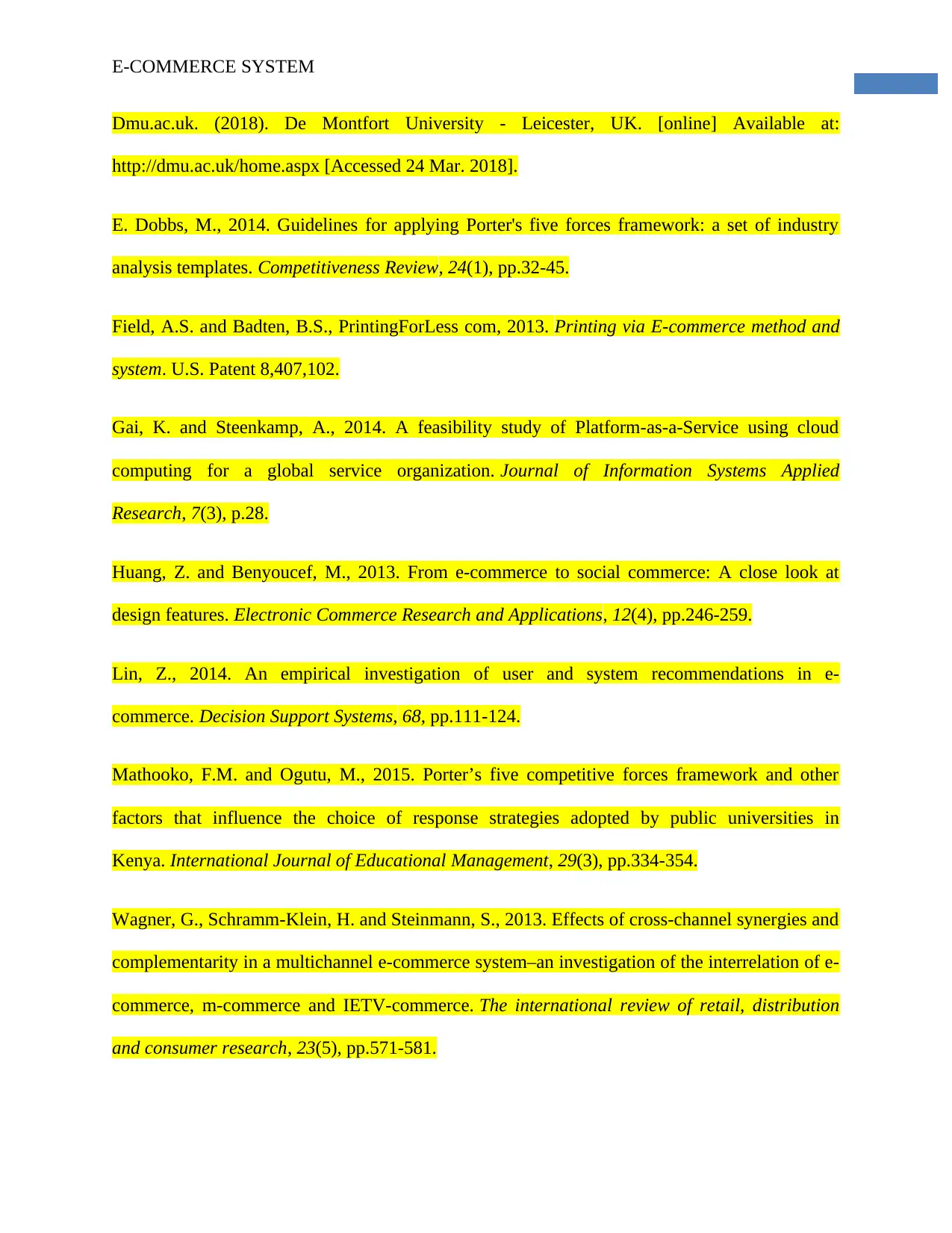
9
E-COMMERCE SYSTEM
Dmu.ac.uk. (2018). De Montfort University - Leicester, UK. [online] Available at:
http://dmu.ac.uk/home.aspx [Accessed 24 Mar. 2018].
E. Dobbs, M., 2014. Guidelines for applying Porter's five forces framework: a set of industry
analysis templates. Competitiveness Review, 24(1), pp.32-45.
Field, A.S. and Badten, B.S., PrintingForLess com, 2013. Printing via E-commerce method and
system. U.S. Patent 8,407,102.
Gai, K. and Steenkamp, A., 2014. A feasibility study of Platform-as-a-Service using cloud
computing for a global service organization. Journal of Information Systems Applied
Research, 7(3), p.28.
Huang, Z. and Benyoucef, M., 2013. From e-commerce to social commerce: A close look at
design features. Electronic Commerce Research and Applications, 12(4), pp.246-259.
Lin, Z., 2014. An empirical investigation of user and system recommendations in e-
commerce. Decision Support Systems, 68, pp.111-124.
Mathooko, F.M. and Ogutu, M., 2015. Porter’s five competitive forces framework and other
factors that influence the choice of response strategies adopted by public universities in
Kenya. International Journal of Educational Management, 29(3), pp.334-354.
Wagner, G., Schramm-Klein, H. and Steinmann, S., 2013. Effects of cross-channel synergies and
complementarity in a multichannel e-commerce system–an investigation of the interrelation of e-
commerce, m-commerce and IETV-commerce. The international review of retail, distribution
and consumer research, 23(5), pp.571-581.
E-COMMERCE SYSTEM
Dmu.ac.uk. (2018). De Montfort University - Leicester, UK. [online] Available at:
http://dmu.ac.uk/home.aspx [Accessed 24 Mar. 2018].
E. Dobbs, M., 2014. Guidelines for applying Porter's five forces framework: a set of industry
analysis templates. Competitiveness Review, 24(1), pp.32-45.
Field, A.S. and Badten, B.S., PrintingForLess com, 2013. Printing via E-commerce method and
system. U.S. Patent 8,407,102.
Gai, K. and Steenkamp, A., 2014. A feasibility study of Platform-as-a-Service using cloud
computing for a global service organization. Journal of Information Systems Applied
Research, 7(3), p.28.
Huang, Z. and Benyoucef, M., 2013. From e-commerce to social commerce: A close look at
design features. Electronic Commerce Research and Applications, 12(4), pp.246-259.
Lin, Z., 2014. An empirical investigation of user and system recommendations in e-
commerce. Decision Support Systems, 68, pp.111-124.
Mathooko, F.M. and Ogutu, M., 2015. Porter’s five competitive forces framework and other
factors that influence the choice of response strategies adopted by public universities in
Kenya. International Journal of Educational Management, 29(3), pp.334-354.
Wagner, G., Schramm-Klein, H. and Steinmann, S., 2013. Effects of cross-channel synergies and
complementarity in a multichannel e-commerce system–an investigation of the interrelation of e-
commerce, m-commerce and IETV-commerce. The international review of retail, distribution
and consumer research, 23(5), pp.571-581.
Paraphrase This Document
Need a fresh take? Get an instant paraphrase of this document with our AI Paraphraser
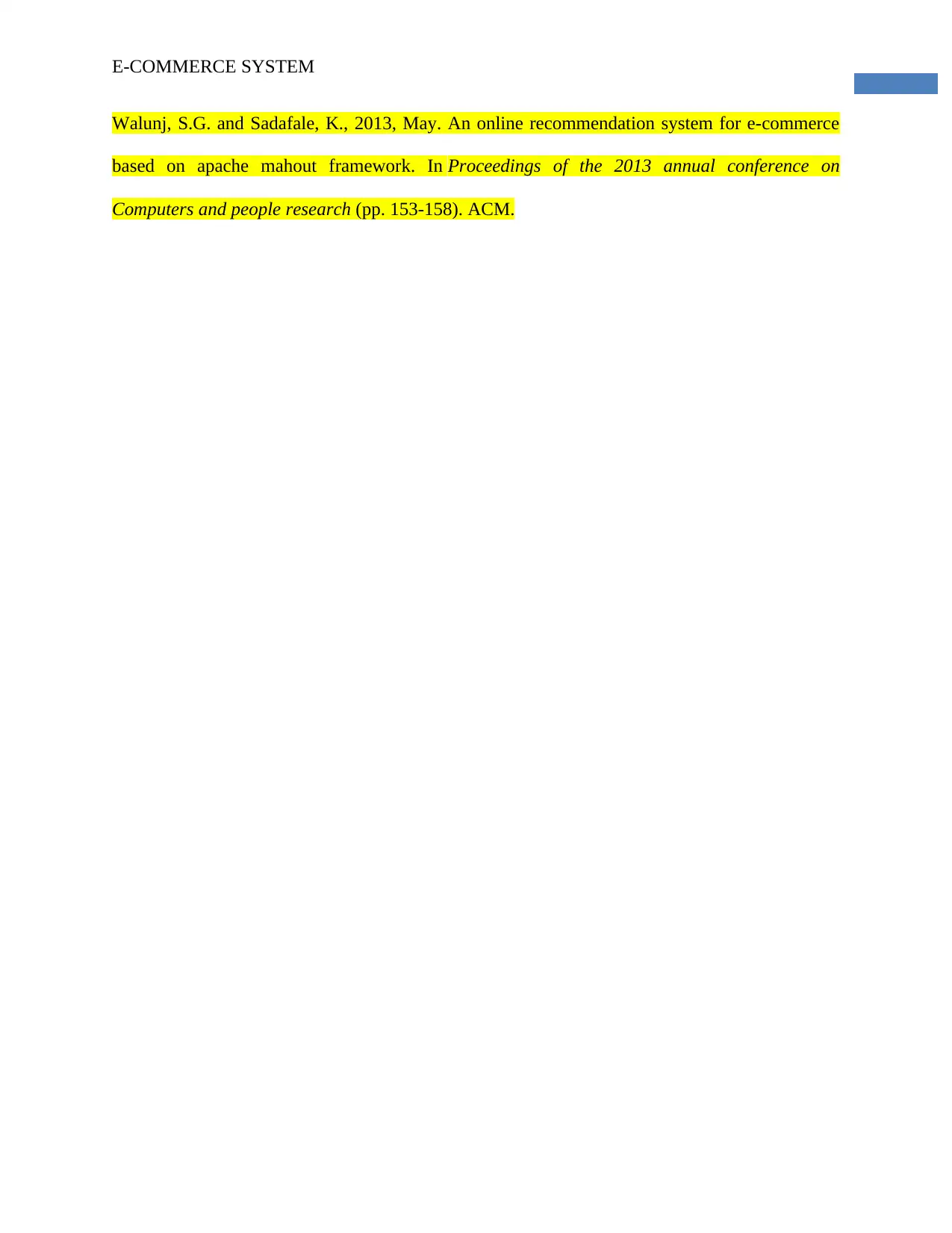
10
E-COMMERCE SYSTEM
Walunj, S.G. and Sadafale, K., 2013, May. An online recommendation system for e-commerce
based on apache mahout framework. In Proceedings of the 2013 annual conference on
Computers and people research (pp. 153-158). ACM.
E-COMMERCE SYSTEM
Walunj, S.G. and Sadafale, K., 2013, May. An online recommendation system for e-commerce
based on apache mahout framework. In Proceedings of the 2013 annual conference on
Computers and people research (pp. 153-158). ACM.
1 out of 11
Related Documents
Your All-in-One AI-Powered Toolkit for Academic Success.
+13062052269
info@desklib.com
Available 24*7 on WhatsApp / Email
![[object Object]](/_next/static/media/star-bottom.7253800d.svg)
Unlock your academic potential
Copyright © 2020–2025 A2Z Services. All Rights Reserved. Developed and managed by ZUCOL.




